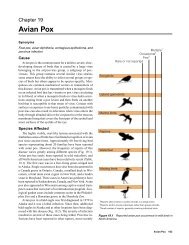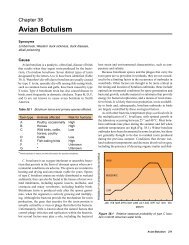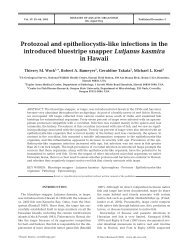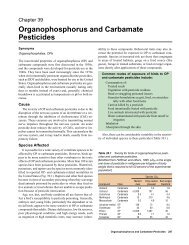Biowarfare, Bioterrorism, and Animal Diseases as Bioweapons
Biowarfare, Bioterrorism, and Animal Diseases as Bioweapons
Biowarfare, Bioterrorism, and Animal Diseases as Bioweapons
Create successful ePaper yourself
Turn your PDF publications into a flip-book with our unique Google optimized e-Paper software.
Box 6–2 Wildlife <strong>as</strong> Dise<strong>as</strong>e Delivery Systems<br />
“Bacteriological warfare is science stood on its head…a gross<br />
perversion.” -from an official paper published by the Soviet Union in<br />
1951 26<br />
In the p<strong>as</strong>t, wildlife have been used <strong>as</strong> delivery systems<br />
for biological warfare, where these free-ranging animals<br />
were captured, infected, <strong>and</strong> rele<strong>as</strong>ed back into the wild to<br />
transmit dise<strong>as</strong>e to others of their kind, <strong>as</strong> well <strong>as</strong> to other<br />
susceptible species. Terrorists could use dise<strong>as</strong>ed wildlife<br />
to convey pathogens to wildlife <strong>and</strong> other species.<br />
During the 19 th , <strong>and</strong> into the 20 th century, Montana Livestock<br />
Sanitary Board (USA) veterinarians used mange<br />
mites (Sarcoptes scabiei) <strong>as</strong> a means for reducing coyote<br />
<strong>and</strong> wolf numbers to protect livestock from depredation.<br />
Healthy coyotes <strong>and</strong> wolves were trapped, infested with<br />
mange mites, <strong>and</strong> rele<strong>as</strong>ed in attempts to initiate mange<br />
epizootics. 149,150 Similar practices targeting dingoes (wild<br />
dogs) took place in Australia. 151<br />
Although mange h<strong>as</strong> long been recognized <strong>as</strong> a human<br />
pathogen, the mange mites infesting coyotes <strong>and</strong> wolves<br />
posed little human health risk because the mites were<br />
host-specific (to canids). 152,153 The situation differed for<br />
ranchers who attempted to employ tularemia (Francisella<br />
tularensis) <strong>as</strong> a biological weapon.<br />
Tularemia is a category A dise<strong>as</strong>e (highest priority) within<br />
the current ranking of critical biological agents for public<br />
health response (Table 6.3). Ranchers in California (USA)<br />
considered any human dise<strong>as</strong>e risks for this dise<strong>as</strong>e <strong>as</strong><br />
260 Dise<strong>as</strong>e Emergence <strong>and</strong> Resurgence: The Wildlife–Human Connection<br />
acceptable, <strong>as</strong> long <strong>as</strong> they could achieve their objective<br />
of reducing small rodent populations. These ranchers<br />
believed the small rodents were competing with livestock<br />
for forage on range <strong>and</strong> gr<strong>as</strong>sl<strong>and</strong>s. So they employed<br />
ground squirrels infected with tularemia <strong>as</strong> vehicles to<br />
help decimate the rodent populations. 154,155 Other notable<br />
examples of wildlife being used <strong>as</strong> vehicles to initiate<br />
infectious dise<strong>as</strong>e epizootics in free-ranging wildlife<br />
populations include myxomatosis <strong>and</strong> viral hemorrhagic<br />
dise<strong>as</strong>e of rabbits (Table A).<br />
Certain infectious dise<strong>as</strong>es used for biological control<br />
can combat unwanted vertebrate species but are seldom<br />
employed because of low success rates <strong>and</strong> inherent risks<br />
to those rele<strong>as</strong>ing the agents. 156–158 Today, there is the<br />
capability to develop genetically modified dise<strong>as</strong>e agents<br />
that may target just a single species, thus reducing the<br />
potential for unwanted effects. Yet, these capabilities can<br />
go <strong>as</strong>tray. Recently, a killer mousepox virus (highly virulent<br />
strain) emerged from a laboratory that genetically engineered<br />
the virulent strain to be a vector-borne contraceptive<br />
for reducing rodent populations. This unexpected killer<br />
virus outcome caused alarm because of the potential for<br />
similar outcomes in viruses that infect humans. This potential<br />
h<strong>as</strong> implications for the development of new biological<br />
weapons. 54,159<br />
The frequent movement of pathogens through the illegal <strong>and</strong> legal transportation of wildlife attests to the need for<br />
concern regarding wildlife <strong>as</strong> potential vehicles for bioterrorism.<br />
Photos by Milton Friend

















